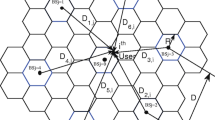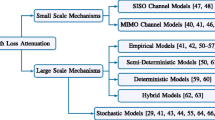Abstract
The development of models that predict path loss in a wireless system is worthwhile since they offer valuable information without the need of expensive and time consuming measurements. In the modeling and simulation of cellular systems, a common assumption in path loss calculation is the circular shape of the cells. However, despite its simplicity, this approach has certain drawbacks. This paper proposes an alternative method that considers hexagonal-shaped cells. Exact analytical and approximate closed-form expressions for the path loss statistics are derived. The validity of the circular cell approximation is discussed. Simulated results and comparisons with measurement data in the literature validate the accuracy of the formulation. Finally, we investigate the impact of the size of the cells and the characteristics of the propagation medium on the path loss. The derived expressions simplify the analysis and system-level simulation of wireless networks. Compared to other methods, they give more accurate results in the calculation of path loss when hexagonal-shaped cells are employed.
Similar content being viewed by others
References
Prasad R., Ruggieri M. (2003) Technology trends in wireless communications. Artech House, Boston
Fathi H., Chakraborty S. S., Prasad R. (2009) Voice over IP in wireless heterogeneous networks: Signaling, mobility and security. Springer, Berlin
Smaoui, H., Zarai, F., Banat, M. M., & Kamoun, L. (2009). Heterogeneous wireless networks: Configuration and vertical handoff management. Wireless Personal Communications. doi:10.1007/s11277-009-9733-0.
Demestichas, P., Katidiotis, A., Petromanolakis, D., & Stavroulaki, V. (2009). Management sys- tem for terminals in the wireless B3G world. Wireless Personal Communications. doi:10.1007/s11277-009-9762-9.
Ghassemzadeh S. S., Jana R., Rice C. W., Turin W., Tarokh V. (2004) Measurement and modeling of an ultra-wide bandwidth indoor channel. IEEE Transactions on Communications 52: 1786–1796
Moraitis N., Constantinou P. (2004) Indoor channel measurements and characterization at 60 GHz for wireless local area network applications. IEEE Transactions on Antennas and Propagation 52: 3180–3189
Holis J., Pechac P. (2008) Elevation dependent shadowing model for mobile communications via high altitude platforms in built-up areas. IEEE Transactions on Antennas and Propagation 56: 1078–1084
Cerri G., Cinalli M., Michetti F., Russo P. (2004) Feed forward neural networks for path loss prediction in urban environment. IEEE Transactions on Antennas and Propagation 52: 3137–3139
Popescu, I., Nikitopoulos, D., Constantinou, P., & Nafornita, I. (2006). Comparison of ANN based models for path loss prediction in indoor environments. Paper presented at the 64th IEEE Vehicular Technology Conference VTC, September 2006, Montreal.
Haenggi M. (2008) A geometric interpretation of fading in wireless networks: Theory and applications. IEEE Transactions on Information Theory 12: 5500–5510
Jan R.-H., Chu H.-C., Lee Y.-F. (2004) Improving the accuracy of cell-based positioning for wireless systems. Computer Networks 46: 817–827
Goldsmith A. (2005) Wireless communications. Cambridge University Press, Cambridge
Hoymann, C., Dittrich, M., & Goebbels, S. (2007). Dimensioning cellular multihop WiMAX networks. Paper presented at the IEEE Mobile WiMAX Symposium 2007, March 2007, Orlando.
Xiao L., Greenstein L., Mandayam N., Periyalwar S. (2008) Distributed measurements for estimating and updating cellular system performance. IEEE Transactions on Communications 56: 991–998
Chan, A., & Liew, S. C. (2007). VoIP capacity over multiple IEEE 802.11 WLANs. Paper presented at the IEEE International Conference on Communications ICC’07, June 2007, Glasgow.
Dou, J., Guo, Z., Cao, J., & Zhang, G. (2008). Lifetime prolonging algorithms for wireless sensor networks. Paper presented at the 4th IEEE International Conference on Circuits and Systems for Communications ICCSC, May 2008, Shanghai.
Choi S.-O., You K.-H. (2008) Channel adaptive power control in the uplink of CDMA systems. Wireless Personal Communications 47: 441–448
Bharucha, Z., & Haas, H. (2008). The distribution of path losses for uniformly distributed nodes in a circle. Research Letters in Communications. doi:10.1155/2008/376895.
Papoulis A., Pillai S. U. (2002) Probability, random variables, and stochastic processes (4th ed.). McGraw-Hill, New York
3GPP and Universal Mobile Universal Mobile Telecommunications System (UMTS). (1998). Selection procedures for the choice of radio transmission technologies of the UMTS, version 3.2.0.
Jordan, M., Senst, M., Cui, Y., Ascheid, G., & Meyr, H. (2007). Downlink based intercell time synchronization using maximum likelihood estimation. Paper presented at the 16th IST Mobile and Wireless Communications Summit, July 2007, Budapest.
Deng L.-Y., Xu H. (2003) A system of high-dimensional, efficient, long-cycle and portable uniform random generators. ACM Transactions on Modeling and Computer Simulation 13: 299–309
Baltzis, K. B. (2008). A geometrical-based model for cochannel interference analysis and capacity estimation of CDMA cellular systems. EURASIP Journal on Wireless Communications and Networking. doi:10.1155/2008/791374.
Baltzis, K. B., & Sahalos, J. N. (2009). On the statistical description of the AoA of the uplink interfering signals in a cellular communication system. European Transactions of Telecommunications. doi:10.1002/ett.1373.
Thiele, L., Peter, M., & Jungnickel, V. (2006). Statistics of the Ricean k-factor at 5.2 Ghz in an urban macro-cell scenario. Paper presented at the 17th IEEE International Symposium on Personal, Indoor and Mobile Radio Communications, September 2006, Helsinki.
Thiele, L., & Jungnickel, V. (2006) Out-of-channel statistics at 5.2 GHz. Paper presented at the First European Conference on Antennas and Propagation EuCAP, November 2006, Nice.
Agbinya J. I. (2006) Design considerations of MoHotS and wireless chain networks. Wireless Personal Communications 40: 91–106
Author information
Authors and Affiliations
Corresponding author
Rights and permissions
About this article
Cite this article
Baltzis, K.B. Analytical and Closed-Form Expressions for the Distribution of Path Loss in Hexagonal Cellular Networks. Wireless Pers Commun 60, 599–610 (2011). https://doi.org/10.1007/s11277-010-9962-2
Published:
Issue Date:
DOI: https://doi.org/10.1007/s11277-010-9962-2




